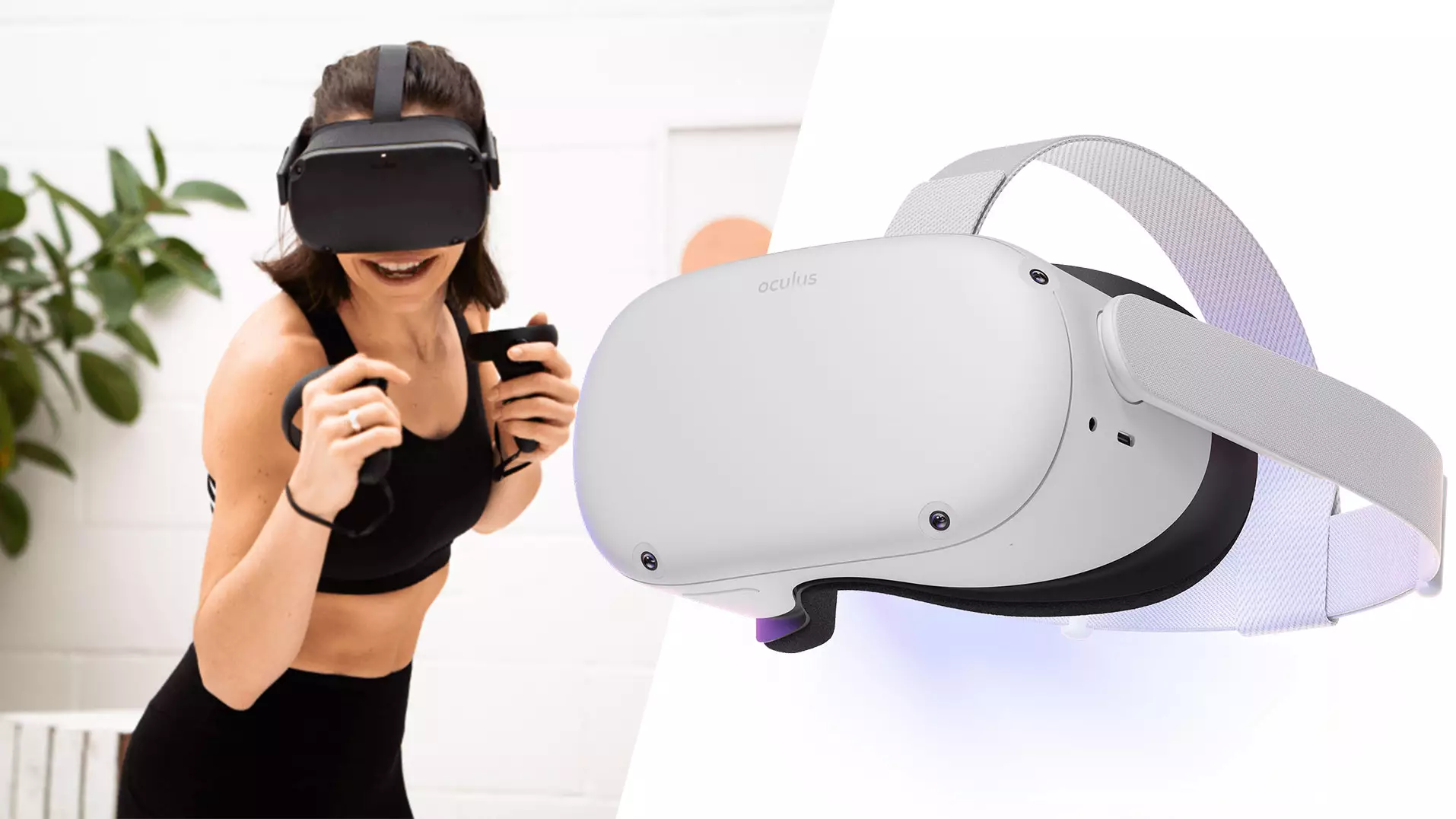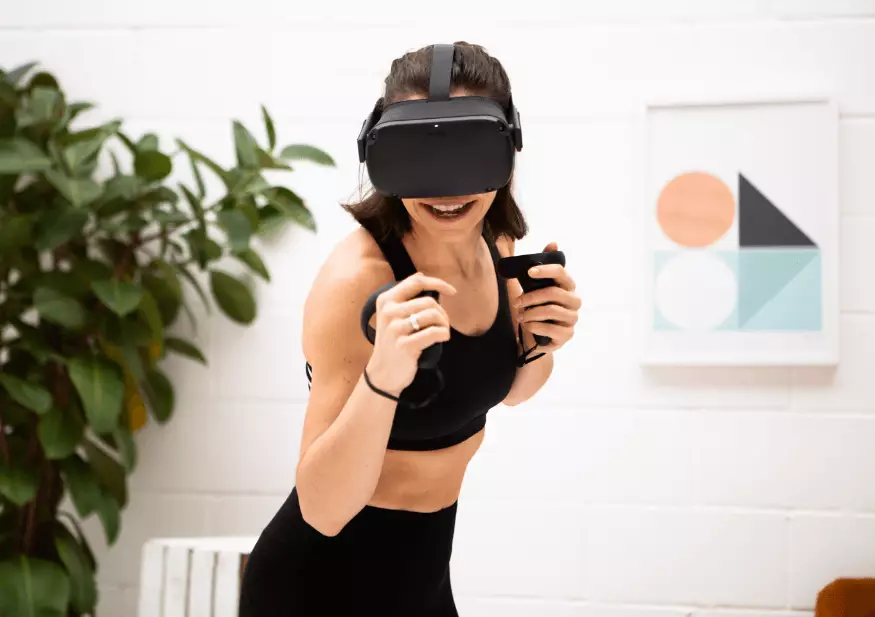
With the launch of Oculus Move, Facebook is angling to show off its virtual reality headset's potential as a piece of exercise equipment. The new app tracks your movement and calorie burn across all the games and software you boot up in the Oculus Quest and Quest 2. Now your hour spent playing Beat Saber followed by a level of Half-Life: Alyx isn't just idle play - it's part of your daily workout.
Oculus Move highlights just how much VR games get you moving around compared to other kinds of gaming. So we've dived in to see how it compares to more regular forms of exercise.
It's really easy to set up Oculus Move. The app is available for free in the Oculus Store and after creating a profile and inputting some information about yourself - your height and weight, for instance - Move will start calculating your calorie burn while using different apps.
Advert
Move runs in the background as soon as you boot up your headset, so everything you do while wearing it is counted towards your activity, so you don't run the risk of forgetting to track an exercise session. Move dishes out two key stats for you: move minutes and calories burned. You can set goals for yourself, such as hitting 45 active move minutes a day. The app isn't particularly pushy about these goals, but you'll get a notification pop up on screen when you hit those targets. It's a nice, reinforcing boost.
The main plus of Move is that it acts as a consistent tracker across every game you play. Some games on Oculus, such as FitXR, have built-in calorie trackers; but others, like Beat Saber, which aren't built as exercise workouts, don't give you that information. With Move installed, whatever game you're playing, you'll be able to find out how active you've been.
Now, calorie trackers are notoriously unreliable and, while they can indicate how active you've been, you shouldn't rely on the data they give you. I've been doing all the Oculus exercises (and a lot of non-Oculus exercises, too) while wearing a Fitbit. I don't particularly trust the calorie counts from Fitbit either, but it has meant I have a consistent tracker across all activities to see how the Oculus compares to other real-world exercises.
Beat Saber doesn't sell itself as a fitness game. It's a rhythm game where, armed with two swords, you have to slash through coloured blocks that stream towards you in time with the game's bassy soundtrack. It's fast-paced, extremely good fun, and a great game to start with if you're new to VR.
Advert
While Beat Saber can become very challenging as you climb the difficulty modes, it's a very intuitive game. It treats the controllers in your hands as though they were the hilts of your two swords. To swipe the sword upwards you simply lift your hand, and you can swing it left and right with a flick of the wrist. There are no buttons to press and all the game's action takes place in front of you, so you don't need to navigate 3D space. It's a really good introduction to what VR can offer. Especially as it's one of those games that makes you feel awesome, even if you may look like a bit of a prat in reality (as evidenced below).
Beat Saber isn't a fitness game but it has you up on your feet swinging your arms about and ducking low to dodge virtual obstacles. It's easy to play in 40-minute chunks, either trying to progress through the game's campaign or just dropping into free play and picking songs from a playlist.
According to Oculus Move, I was burning through calories as I played. After a 40-minute session the app was telling me I'd burned 447 calories, which isn't too far off the 479 calories my Fitbit was telling me. Just to say again, I don't know how accurate either number is, but the Fitbit is what I'm going to use consistently across the different games and non-VR exercises, to have a comparison to the Move data.
Advert
I am surprised by the numbers Oculus and Fitbit are saying Beat Saber's burning, because I didn't build up a sweat while playing or really feel worked out after I stopped playing. But, certainly, it's more active than any games I'd been playing on my PC.
As you can guess from the name, FitXR makes no bones about being a fitness game. It's a collection of different workout classes that you can pick from a list, filtering by time, intensity, and music genre. The boxing class is very similar to Beat Saber - you stand in the centre of your play space and punch targets as they flow towards you in a stream, in time to the soundtrack.
The moves themselves are simple. Punch-wise you're only asked to jab, cross, uppercut, and hook your targets, and sometimes you'll need to bring your fists up to block or duck below a barrier.
Advert
While the routines are simple the workouts can be very heavy going. If you pick an 'intense' workout, the targets speed towards you in a rapid flurry. After a ten-minute session I'd built up a sweat and my heart was racing. After 40 minutes, I'd sweat running down my back and legs. Not a pretty image, I know, but it was a much more intense workout than Beat Saber and my Fitbit agrees. According to the tracker, in 40 minutes, doing two 10-minute 'moderate' sessions and a 20-minute 'intense' session, I burned 509kcal.
Now, this is where some of my distrust with the Oculus' fitness tracking comes in. According to Oculus Move I burned 412kcal during that 40-minute session. FitXR's own calorie counter said I'd burned over 1,000kcal. While I've no idea which number, Fitbit's or Oculus', is closer to the truth, I'm surprised Oculus said I burned more calories playing Beat Saber. That felt like nowhere near as rigorous a workout - it didn't get my heart pumping as fast, it didn't make me sweat as much, and it didn't leave me as tired as FitXR.

While exercise may be about self-improvement for most people, I'm disgustingly competitive so I love that FitXR features multiplayer. When you load into the class you can see your competitors' avatars lined up either side of you and an always visible leaderboard provides gentle pressure to push harder. You get extra points for building up a streak of hits and the harder you punch the more score each punch gets you. Though, you can play solo if you'd prefer.
Advert
Your scores for each session are logged, too, so if you repeat the same workouts you're nudged to try and improve your scores each time. All of this works together to make a really compelling workout game. I now spend most lunch times playing for 40 minutes, and trying to edge up my scores.
FitXR has got its downsides but they aren't unique to the game, they're more to do with the nature of VR equipment. Even using the Oculus Quest 2, a relatively light and comfortable headset that doesn't need to be wired up to a PC, after 20 minutes of intense workout I started having problems. For one, normally when boxing you'd have your fists closed, but with Oculus you need to hold its controllers, which puts you hands into a less comfortable position. You also need to avoid pressing any of the controllers' buttons as you punch and block because you can open up menus that pause your workout. However, the biggest issue is sweat: it soaks into the foam cushioning of the headset. It's unpleasant to put on a headset and find it damp with sweat hours after you last used it - and that's my own sweat. I'd hate for a friend to use the headset after I'd been working out in it.

Using the Fitbit as a measure, the Oculus workouts compare pretty favourably to non-VR exercises. A 50-minute ride on my exercise bike was logged as 734 calories and a 40-minute HIIT class logged 328 calories burned. Though, this is only looking at calorie counts. While the HIIT class looks low compared to all the other exercises, that was the one that felt like the toughest workout of them all and left me with sore muscles for days afterwards.
This is one of the challenges when it comes to comparing all these different workouts. Something that doesn't come across in the VR workouts is that you aren't working with much resistance. In the HIIT class you're doing press ups, sit ups, and plank variations - all exercises that have you lift your own body's weight. With the VR exercises you're shadowboxing. It's good cardio and gets your heart pumping but your muscles aren't being strained much beyond the stamina of the exercise. They're pushing for different kinds of fitness, which is something to keep in mind.

So, should you buy an Oculus headset if you want to get fit? There are loads of free games available in the Oculus store that will get you up and moving. And, as soon as Beat Saber releases Taylor Swift DLC I will happily pay a premium to swing swords along to her music. With the launch of the Move app it's easier to track that fitness and give you both an indication of how active you're being and a little motivation to keep pushing a little bit further.
However, if fitness is your primary goal and you've the £300 available to get a headset, I wouldn't buy a Quest 2 just yet. For that sort of money you can get all the basics you'd need for a home gym - weights, resistance bands, a mat, and even some large equipment like a foldable exercise bike. You'll be more physically comfortable exercising with actual exercise equipment than you will be using the VR headset and controllers. That's not a knock on the VR headset, as exercise equipment is specifically designed for this, the Oculus is a device with loads of different applications. And while in-person gym classes and personal trainers may not be as available right now, there is a wealth of videos to follow along with online.
But if you have a VR headset or you were planning to buy one for its games anyway, the Oculus is a great way to get some activity into your day. Whether it's just getting yourself moving with Beat Saber or actually blocking out some time for an intense workout with FitXR, it's surprisingly easy to lose track of time and work up a sweat with the Quest 2.
While I'm still going to be primarily using my bike to burn calories, I've already started working a few sessions of FitXR into my week to keep my arms, back, and chest active between HIIT classes. For me, it won't replace dedicated exercises, but it's a wonderful thing to break up my routine - particularly during lockdown, where life is fast becoming extremely repetitive.
An Oculus Quest 2 was provided by Facebook.
Featured Image Credit: Facebook